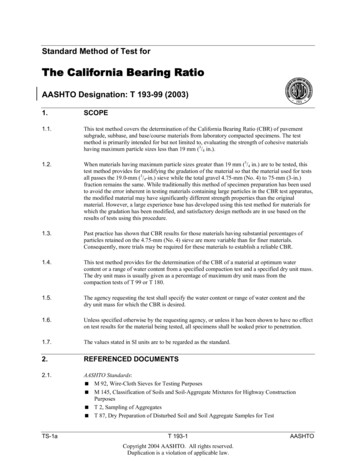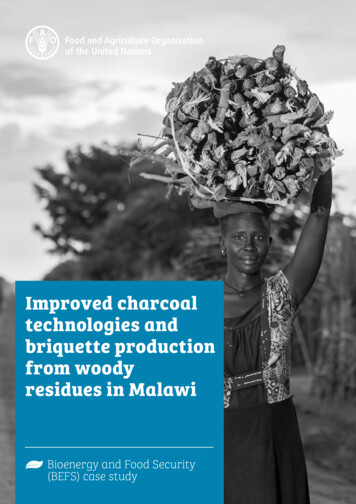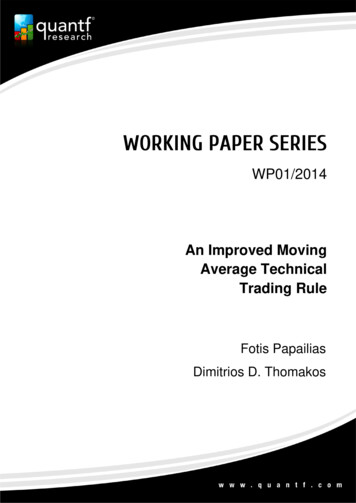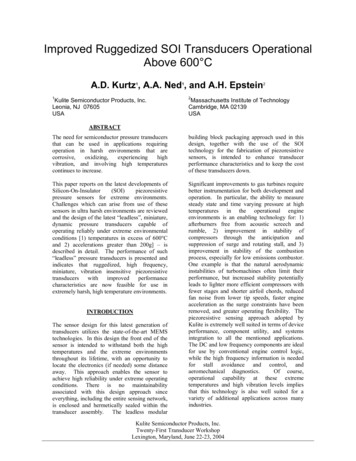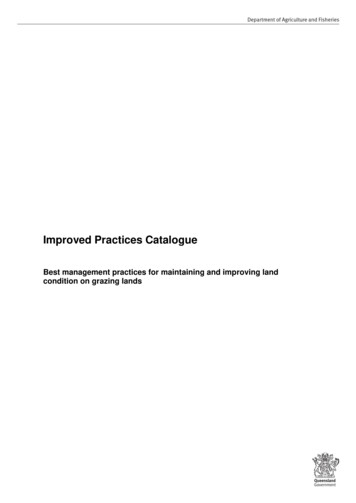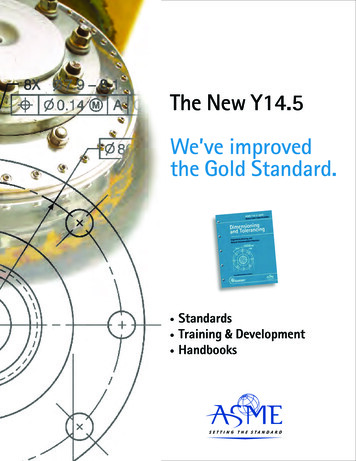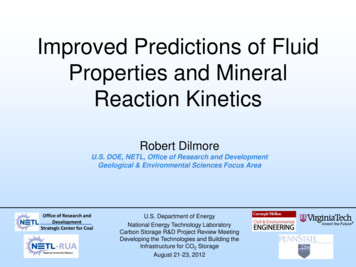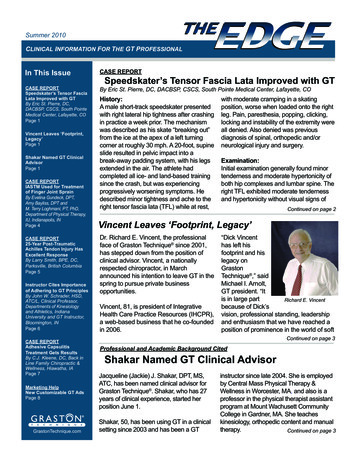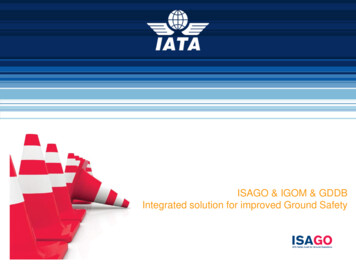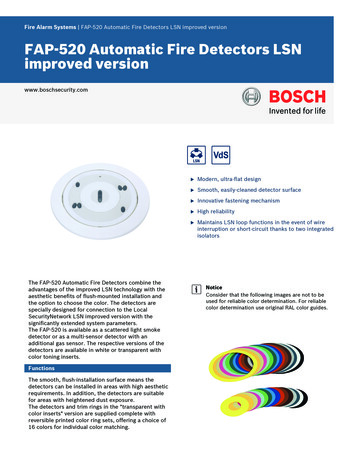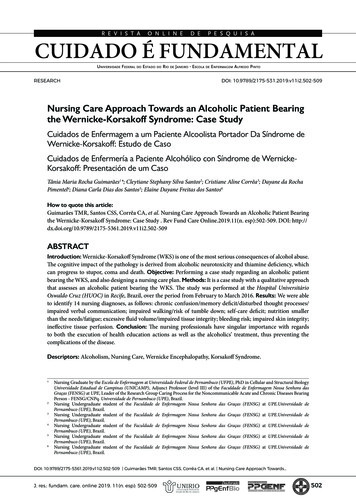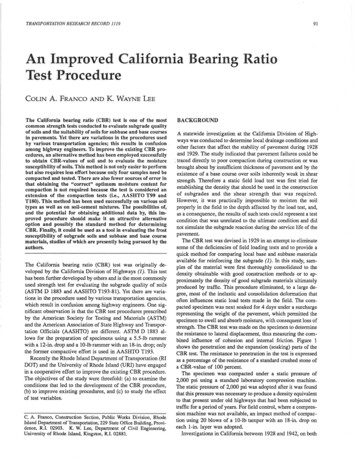
Transcription
TRANSPORTATION RESEARCH RECORD 111991An Improved California Bearing RatioTest ProcedureCOLINA.FRANCO ANDK.WAYNE LEEThe California bearing ratio (CBR) test is one of the mostcommon strength tests conducted to evaluate subgrade qualityof soils and the suitability of soils for sub base and base coursesin pavements. Yet there are variations in the procedures usedby various transportation agencies; this results in confusionamong highway engineers. To Improve the existing CBR procedures, an alternative method has been employed successfullyto obtain CBR-values of soil and to evaluate the moisturesusceptibility of soils. This method is not only easier to performbut also requires less effort because only four samples need becompacted and tested. There are also fewer sources of error inthat obtaining the "correct" optimum moisture content forcompaction is not required because the test Is considered anextension of the compaction tests (i.e., AASHTO T99 andTl80). This method has been used successfully on various soiltypes as well as on soil-cement mixtures. The possibilities of,and the potential for obtaining additional data by, this improved procedure should make It an attractive alternativeoption and possibly the standard method for determiningCBR. Finally, It could be used as a tool in evaluating the frostsusceptibility of subgrade soils and subbase and base coursematerials, studies of which are presently being pursued by theauthors.The California bearing ratio (CBR) test was originally developed by the California Division of Highways (1). This testhas been further developed by others and is the most commonlyused strength test for evaluating the subgrade quality of soils(ASTM D 1883 and AASHTO T193-81). Yet there are variations in the procedure used by various transportation agencies,which result in confusion among highway engineers. One significant observation is that the CBR test procedures prescribedby the American Society for Testing and Materials (ASTM)and the American Association of State Highway and Transportation Officials (AASHTO) are different. ASTM D 1883 allows for the preparation of specimens using a 5.5-lb rarnmerwith a 12-in. drop and a 10-lb rarnmer with an 18-in. drop; onlythe former compactive effort is used in AASHTO T193.Recently the Rhode Island Department of Transportation (RIDOT) and the University of Rhode Island (URI) have engagedin a cooperative effort to improve the existing CBR procedure.The objectives of the study were threefold: (a) to examine theconditions that led to the development of the CBR procedure,(b) to improve existing procedures, and (c) to study the effectof test variables.C. A. Franco, Construction Section, Public Works Division, RhodeIsland Department of Transportation, 229 State Office Building, Providence, R.I. 02903. K. W. Lee, Department of Civil Engineering,University of Rhode Island, Kingston, R.I. 02881.BACKGROUNDA statewide investigation at the California Division of Highways was conducted to determine local drainage conditions andother factors that affect the stability of pavement during 1928and 1929. The study indicated that pavement failures could be·. traced directly to poor compaction during construction or wasbrought about by insufficient thickness of pavement and by theexistence of a base course over soils inherently weak in shearstrength. Therefore a static field load test was first tried forestablishing the density that should be used in the constructionof subgrades and the shear strength that was required.However, it was practically impossible to moisten the soilproperly in the field to the depth affected by the load test, and,as a consequence, the results of such tests could represent a testcondition that was unrelated to the ultimate condition and didnot simulate the subgrade reaction during the service life of thepavement.The CBR test was devised in 1929 in an attempt to eliminatesome of the deficiencies of field loading tests and to provide aquick method for comparing local base and subbase materialsavailable for reinforcing the subgrade (1). In this study, samples of the material were first thoroughly consolidated to thedensity obtainable with good construction methods or to approximately the density of good subgrade materials ultimatelyproduced by traffic. This procedure eliminated, to a large degree, most of the inelastic and consolidation deformation thatoften influences static load tests made in the field. The compacted specimen was next soaked for 4 days under a surchargerepresenting the weight of the pavement, which permitted thespecimen to swell and absorb moisture, with consequent loss ofstrength. The CBR test was made on the specimen to determinethe resistance to lateral displacement, thus measuring the combined influence of cohesion and internal friction. Figure 1shows the penetration and the expansion (soaking) parts of theCBR test. The resistance to penetration in the test is expressedas a percentage of the resistance of a standard crushed stone ofa CBR-value of 100 percent.The specimen was compacted under a static pressure of2,000 psi using a standard laboratory compression machine.The static pressure of 2,000 psi was adopted after it was foundthat this pressure was necessary to produce a density equivalentto that present under old highways that had been subjected totraffic for a period of years. For field control, where a compression machine was not available, an impact method of compaction using 20 blows of a 10-lb tamper with an 18-in. drop oneach 1-in. layer was adopted.Investigations in California between 1928 and 1942, on both
TRANSPORTATION RESEARCH RECORD 111992HeadPenetration pistonTapered lugs(a) PENETRATION TESTPortable gage and tripodApproximate water levelPerforated plate(b) EXPANSION TESTFIGURE 1 California bearing ratio test apparatus.adequate pavements and flexible pavements that failed, furnished considerable empirical data for correlation of the CBRrequirements with service behavior. From these data, curveswere formulated for determining the thickness of pavement andbase course required to carry traffic adequately over compactedsubbase and subgrade materi1;1ls (2, p. 6).Gradually it was realized that neither the California static northe California dynamic compaction test is desirable in the field(3). The U.S. Army Corps ofEngineers (USACE) modified theAASHO designation T99-38 for compaction control testing(4 ). This modification consisted of increasing the weight of thehammer from 5.5 lb to 10 lb, the height of drop from 12 in. to18 in., and Lbe number of layers in which the soil was placed inthe mold from three to five. A comparison of compactiveefforts from limited data available indicated that the densityresults obtained by this modification of the AASHO compaction test closely approximated lhose obtained by lhe Californiadynamic compaction tests (3 ). The modified compaction testfirst appeared as a construction control in June 1942 (5) and hassince become known as the modified AASHTO compactiontest. However, the densities of samples prepared for the CBRtest were at considerable variance with those obtained by fieldequipment, especially for sandy materials of low plasticity.This led to further modification so that, when penetrated, thespecimens would more nearly reflect the relative stability of Lbesoil as compacted during construction and as later affected bymoisture changes. The use of the impact method for the preparation of remolded specimens for design tests was adopted as asecond modification by the USACE in September 1942.A program for the further modification and refinement of theCBR procedure was formulated in November 1942 and conducted by the USACE (6). The laboratory investigation showedthat variations in CBR test results are largely explained by themethod of preparing the test specimens: mainly molding watercontent, density, and method of compaction. The USACE stipulated that the compaction test should be performed in a 6-in.diameter CBR mold using 55 blows per layer, whenever themodified AASHO method of control compaction is specified.Two methods of specimen preparation were also recommended: Method 1 for plastic soils that exhibit little or no swellwhen no unusual construction or weather conditions exist andMethod 2 for plastic soils lhat exhibit little or no swell whenunusual construction and weather conditions occur and for soilsthat are very susceptible to changes in moisture. These compaction and penetration test procedures were standardized asASTM D 1557-58T and D 1883-61, respectively. It should benoted that specimens are prepared using only a 5.5-lb hammerdropped from a height of 12 in. in AASHTO T193.
93Franco and Lee1.95IMPROVED CBR PROCEDUREMODThe new procedure was conceived by the authors who hadworked in Africa and the Middle East where an expedientmethod that used less ph1sical effort was required. As in thetraditional method specified in ASTM D 1883 andAASHTO T193, the objective of this improved procedure is todetermine the CBR value of a soil. In addition to the CBR thefollowing information is also obtained:.:;' 1.93 (.) 1.91 1.89 . ··-DRy CBR40/30Ci5zUJ0 a:1. 870ce"'In this method, a 30-kg sample is dried and pretreated forcompaction per AASHTO T99 or T180 depending on the usethat the soil is to be put to. The soil is split into four portions ofapproximately 6 kg each. To each portion, a definite quantity ofwater is added such that each of the portions of soil has agradually increasing moisture content that ranges around theoptimum moisture content. The individual portions are thencompacted (the moisture content samples are taken at thebeginning and end of the individual compactions; 100 g forfine-grained soils and 500 g for coarse-grained soils). Thecompacted soil in the mold is trimmed even with the topsurface, and the specimen and mold are weighed to determinewet density and finally dry density.Penetration TestThe CBR of a material is obtained for the dry and the soakedcondition. For the dry condition, the penetration test is performed directly on one side of the specimen in the mold (i.e.,either top or bottom). For the soaked condition, the soakingprocedure of AASHTO T193 or ASTM D 1883 is followed.After the percent swell has been determined, the penetrationtest is run on the other side.CalculationsData obtained from the four specimens are plotted with themoisture content as the common axis or abscissa and thedensity as the left-side ordinate. The moisture content corresponding to the peak of the curve shall be termed the optimummoisture content (OMC). Two more curves are plotted on thesame graph with the moisture content as abscissa and the dryand soaked CBR-values as right-side ordinate. The point wherethese curves intercept the OMC line will be the CBR-values ofthe soil (Figure 2).Variables and DiscussionThe original CBR procedure, which ordinarily requires at leastseven specimens, provides three relationships: dry density20SOAKED CBRID(.)oP.,1 - - -s -·,.--1.851.838100OMC910111213MOISTURE CONTENT,Sample Preparation'*ri0 Variation of CBR with moisture content and Comparison of dry CBR- versus soaked CBR-values,which gives a measure of CBR moisture susceptibility.50DRY CBR141516%FIGURE 2 Calculation of dry and soaked CBR-values withthe Improved procedure (Sample 5).versus moisture content, dry CBR versus dry density, andsoaked CBR versus dry density. The suggested procedure requires only four specimens and gives three more relationships:dry CBR versus moisture content, soaked CBR versus moisturecontent, and dry CBR versus soaked CBR.In the improved procedure, the moisture content of thesample is not predetermined nor is it a prerequisite that adefinite value be attained. The original method requires theattainment of the OMC as a prerequisite for each of the threespecimens, and this is not easy to achieve. According to RhodeIsland's experience, it was found that the target OMC was offby 1/2 to 1 percent. This may not appear to be much of avariation, but going back to the CBR curves obtained in theimproved procedure it was observed that the CBR generallyfalls sharply with increased moisture content when the moisture content is greater than optimum (7, pp. 163-171). Thiscould introduce an error in the CBR-values obtained. In addition, it is known that in most cases the moisture content of asoil has a considerably greater effect on the CBR-value than themaximum dry density (MDD). This suggested procedure ablydemonstrated the same.The relationship between dry CBR and soaked CBR is quiteuseful because it can give a quantifiable measure of CBRmoisture susceptibility. The moisture susceptibility here is defined asCBRMS Soaked CBRDry CBR*lOOwhere CBRMS is California bearing ratio moisturesusceptibility.It is worth noting that the greater the percentage CBRMS,the less critical is the moisture susceptibility. This value couldbe used in determining the suitability of a soil as subgrade,subbase, or base in areas where excessive moisture would posea problem. For example, it can generally be said that a sandygravel soil would not be as susceptible as a fine-grained siltyclay soil. The point here is that sandy gravels are better suitedas subgrades than are silts and clays.Table 1 gives a comparison of the "new improved method"
94TRANSPORTATION RESEARCH RECORD 1119TABLE 1 COMPARISON OF CURRENT AASHTO T193 AND NEW METHODAASHTO Method (T-193)New Improved CBR Method1.Sample size approximately 35 kg1.Sample size approximately 30 kg2.Pretreat sample as for ASTM/AASHTO procedure forcompaction test2.Pretreat sample as for ASTM/AASHTO procedure forcompaction test3.Divide the pretreated soil from 2 into one portion weighing 12kg for obtaining the compaction curve (f 99{f 180) andthree portions weighing 6 kg each for CBR testing3.Divide the pretreated soil from 2 into four portions weighing 6kg each4a.Perform compaction test according to standard procedure(T 99{f 180) using either four or five points4a.Pe
ASTM D 1557-58T and D 1883-61, respectively. It should be noted that specimens are prepared using only a 5.5-lb hammer dropped from a height of 12 in. in AASHTO T193. Franco and Lee IMPROVED CBR PROCEDURE The new procedure was conceived by the authors who had worked in Africa and the Middle East where an expedient method that used less ph1sical effort was required. As in the
